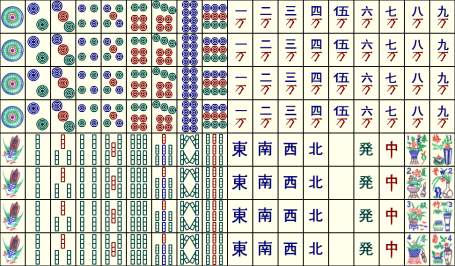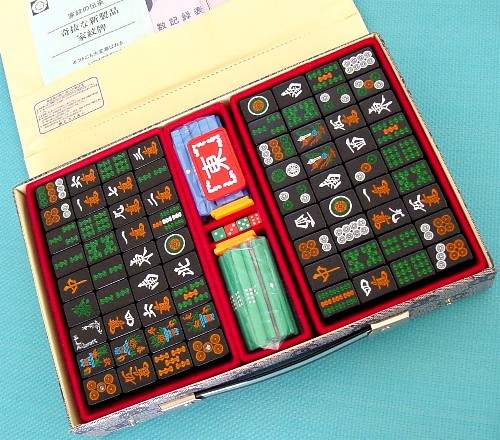
FAQ 7a. Different Types of Mah-Jongg Sets
Different types of mah-jongg sets are suitable for different types of mah-jongg. You must make sure that you get the type of set that's suitable for the type of mah-jongg that you play! One of the single most important characteristics of a set is the number of tiles in it. It's not hard to count or calculate the tiles, especially when the tiles are packaged in neat even rows.
If you are interested in buying a Mah-Jongg set (either to play the game of
Mah-Jongg or to play the tile-matching game of Shanghai), there are many places
to shop. You should base your selection on:
The picture below shows the tiles of a typical modern American set.
(1) the type of Mah-Jongg you wish to play (how many tiles does your game require, and does your game require any special mah-jongg tiles);
If you buy a beautiful set but can't use it to play, well, the set is useless for you! Somebody else may well be able to enjoy the set, but you should get a different type of set. You need to make sure you know what you need and want. This FAQ is designed to help you with that.
Different sets are comprised of different numbers of tiles, and may or may not
come with specific special tiles. Let's take a look at a few representative set types.
(2) whether or not you can read the Chinese characters of the Craks suit without
Western indices (Arabic numerals and Roman letters);
(3) what looks and feels nice to you.

Please examine the picture and observe the following:
When you buy an American set, it usually comes in a long case as shown below:

American sets come with four or five racks, two or more dice, and some type of wind indicator. American players need a card (shown: the 2001 NMJL card). Often these sets contain extra tiles (extra flowers, jokers, and/or blanks), and colored chips (circular chips with a square hole, reminiscent of old Chinese coins). For more information about those "bits and pieces", see FAQ 7d. For information about the NMJL card, see FAQ 7i. American-style sets are more expensive than Asian-style sets, due to the inclusion of extra tiles and extra accessories. A new American-style set can cost from $80 to $120 (and even more, for special sets of higher-quality materials). NOTE: If you buy an American set, you can use it to play Chinese mah-jongg as well (there are more than the required number of tiles present). But Chinese sets cannot be used to play American mah-jongg (not enough tiles). So if you might want to use your set to play American mah-jongg some day, buy an American set and you can't go wrong.
Here's a picture of an older American-style "Mah-Lowe" set, probably from the 1950s or 1960s.

I had assumed these tiles of mine were bakelite, but a radio collector friend of mine says yellow mah-jongg tiles are instead catalin (see the Plastics FAQ - FAQ 7c3). This set didn't have enough jokers to play the modern American game, but it had extra flowers, so I made joker labels on my computer printer.
This type of set typically goes for from $90-200 on Ebay ("enrobed" tiles go for much more).


The backs of some enrobed tiles. Sets with enrobed tiles and genuine ivory tiles are the two most valuable types of sets.
The picture below shows the tiles of a typical Chinese set.

Notice the following characteristics in this set:
Modern Chinese sets often come in cloth-covered cardboard cases or cheap vinyl cases, and are often fairly inexpensive; maybe around $50.
Another typical sort of Chinese set which is widely available is the 1920s set. The tiles below are from a cowbone-and-bamboo set from the 1920s.

Boxed bone and bamboo Chinese sets, like the one below, were all the rage worldwide in the Roaring Twenties.

For a short description of the typical 1920s boxed set of bone and bamboo tiles, see Column 610.
Note the characteristics typical of many 1920s sets:
1920s sets are available every day on Ebay. Depending on condition and completeness (and quality of presentation), an 1920s set might go for $80 or as much as $600 (see FAQ 7h).
Here's a HONG KONG mah-jongg set:

Hong Kong sets usually are very heavy. The tiles are very large. This set comes with poker chips, 3 dice, a cubical wind indicator in holder, no Western indices on the tiles, and a cheap vinyl case. Playing with this set is an experience! Sets like this (sometimes with Western indices) are often available on eBay. (Also, note how the set is packaged, with tiles laid out flat in 4 trays. Each tray is 4 rows of 9 tiles each. 4x9=36, x4=144. It's not hard to count the tiles when you lay them all out in even rows like this. Driving the point home: it's important to know how many tiles are in a set when buying or selling a set.)
These HK sets are the cheapest type of set. Don't pay more than $40 max!
The picture below shows the tiles of a modern Japanese set.

You can easily recognize the modern Japanese set because of these characteristics:
Japanese sets come in a small case with dice, a 2-sided wind indicator (seen here in red), and counting sticks. I have also purchased and added four yakitori markers (seen here in orange; these can be purchased from the AMJA, since I purchased a number of these for the AMJA when I went on a trip to Japan). No racks (only Westerners seem to need racks). For more information about those "bits and pieces", see FAQ 7d. Japanese sets are typically quite expensive (around $110-120).

You can also find very beautiful black sets like this one:


Pictured above: a Rummikub set. NOT a mahjong set at all. The one pictured is probably incomplete. The only reason you might come here and ask me what such a thing is is because its rules sheet has been lost. You can get the rules for Rummikub at PressmanGames.com and at pagat.com (pagat.com being the most comprehensive resource for rules for card games - and Rummikub being essentially a card game with stiff thick cards). Photo courtesy Colleen Paradis, July 31 2006.
TILE SIZES:
Here are the dimensions of typical American tiles (this is also the size of most tiles used in England and Europe today): Here are the dimensions of typical Vietnamese tiles: Bone and bamboo tiles can vary in size:
Tiles come in other sizes too. The Chinese are becoming increasingly fond of big tiles; American and European tiles are medium-sized; the Japanese prefer smaller thicker tiles. On a 2007 visit to San Francisco's Chinatown, in neighboring shops Kwong Sang Lung Co. and Kwong Sang Tong Co. (at 947 and 941 Grant Street respectively), I observed some sets being marked with size numbers.
This shop carried sets marked as sizes 9, 8, 7½, 7, and 小. I wasn't able to get exact measurements, and for all I know this is just one manufacturer's sizing system, but perhaps this will help:
The shop also sold a variety of even smaller tiles, but those were not marked with size numbers.
TABLE SETUPS:
American players often ask me "how do Chinese players play without racks and cards?". Players of any of the many un-American varieties of mah-jongg often ask me, when they see the racks and cards, "what on earth are those things?"
Let's briefly look at a few of the many flavors of mah-jongg, from the eyes of someone who is familiar with a different flavor.
First, here's how the Japanese might set up a game, if playing on a regular card table:
American players, observing this Japanese table setup, would probably remark on these unusual features:
From left to right: Japanese, American, Hong Kong, and Vietnamese tiles.
H = 3cm (1-5/32")
Here are the dimensions of typical Japanese tiles:
W = 2.1 to 2.2cm (29/32" to 7/8")
D = 1.3 to 1.4cm (15/32" to 17/32")
H = 2.5cm (1")
Here are the dimensions of typical Hong Kong tiles:
W = 1.8cm (23/32")
D = 1.6cm (19/32")
H = 3.7cm (1-7/16")
W = 2.8cm (1-3/32")
D = 2.2cm (7/8")
H = 3.6cm (1-7/16")
W = 2.7cm (1-3/32")
D = 2.3cm (29/32")
H = 2.4 to 2.9cm (15/16" to 1-5/32")
W = 1.75 to 2.2cm (3/4" to 7/8")
D = 1.1 to 1.2cm (15/32" to 1/2")
And smaller bone and bamboo tiles are also not uncommon (usually made for use as "travel sets").

9 - This corresponds roughly to Vietnamese size (above).
8 - Typical Hong Kong size (see above).
7½ - Medium large.
7 - Roughly corresponds to the size of typical American tiles.
小 ("small") - Roughly corresponds to the size of Japanese tiles, but not as thick.

For pictures of Japanese dealing machines (the special mechanical table normally used by Japanese players), visit my "Mah-Jongg Friends" page.
Now let's take a look at a typical American table setup:

Japanese players, seeing such an American table setup for the first time, would note these unusual features:

Note these unusual features:
IN CONCLUSION:
Mah-Jongg sets come in many different configurations:
You need to make sure that you get the right kind of set for the kind of mah-jongg that you play.
If you appreciate the free information on this site, your donation would be gratefully accepted, and would help keep this site running as a free service. Thank you!
Copyright 2001-2016 Tom Sloper. All rights reserved.